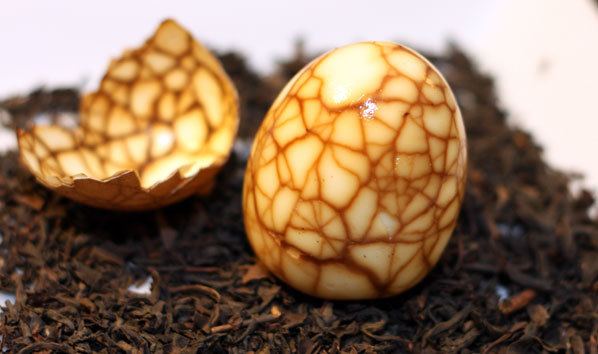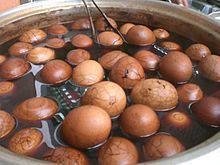Place of origin China | ||
 | ||
Similar Egg as food, Tea, Five‑spice powder, Soy egg, Red cooking | ||
How to make chinese tea eggs easy and delicious
Tea egg is a typical Chinese savory food commonly sold as a snack, in which a boiled egg is cracked and then boiled again in tea, sauce and/or spices. It is also known as marble egg because cracks in the egg shell create darkened lines with marble-like patterns. Commonly sold by street vendors or in night markets in most Chinese communities throughout the world, it is also commonly served in Asian restaurants. Although it originated from China and is traditionally associated with Chinese cuisine, other similar recipes and variations have been developed throughout Asia.
Contents
- How to make chinese tea eggs easy and delicious
- Dragon s eggs chinese tea egg recipe
- Regulartraditional method
- Quick method
- Appearance and flavor
- Chinese Mainland
- Taiwan
- Indonesia
- Malaysia
- References

Dragon s eggs chinese tea egg recipe
Regular/traditional method

Fragrant and flavorful tea eggs are a traditional Chinese food. The original recipe uses various spices, soy sauce, and black tea leaves. A commonly used spice for flavoring tea eggs is Chinese five-spice powder, which contains ground cinnamon, star anise, fennel seeds, cloves and Szechuan peppercorns. Some recipes do not use tea leaves, but they are still called "tea eggs". In the traditional method of preparation, eggs are boiled until they reach a hardened, cooked state. The boiled eggs are removed from the water, and the entire shell of each egg is gently cracked all around. Smaller cracks produce more marbling, visible when the egg is peeled for eating. The extra water from the boiling should be allowed to seep out of the eggs on its own. After about ten minutes, the cracked eggs are ready to be put into the prepared spiced-tea liquid and simmered at medium heat. The simmering allows the spiced fluid to seep into the cracks and marinate the eggs inside their shells. After about 20 minutes, the eggs and the spiced-tea liquid should be transferred to a glass or ceramic container for further steeping in a refrigerator. For best results, the eggs should be allowed to steep for several hours or longer. The dark color of the spiced tea gives the egg a marbled effect when it is peeled to be eaten.
Quick method

Another method of making tea eggs is to boil the eggs until fully cooked inside, then remove the hard boiled eggs from their shells and let them steep in the spiced tea mixture at low heat for a little longer. The eggs and the mixture are removed from the heat and transferred to a glass or ceramic container for further steeping. This method requires a shorter steeping time than the traditional method, however, the egg is less visually appealing without the marbled effect from the traditional crack shell method of preparation. The eggs can be eaten at any time; however, the longer they are allowed to steep, the richer the flavor will be. The perfect spiced-tea egg should have a balance between the egg's natural flavor and that of the spices. The cracking method is the formal feature in this traditional egg recipe.
Appearance and flavor

In the end, when the peel comes off, the egg should have regions of light and dark brown, with mid-brownish tone along the cracks of the shell. The yolk should have a thin, greyish layer, with the core being the usual yellow. As for flavor, it depends on which tea (the type and strength) and the variety of spices used. Five-spice powder adds a savory, slightly salty tone to the white, and the tea should bring out the yolk's flavor.
Chinese Mainland
In China, tea eggs are a household treat. They are also sold in stores, restaurants, and from street vendors.
Taiwan
In Taiwan, tea eggs are a fixture of convenience stores. Through 7-Eleven chains alone, an average of 40 million tea eggs are sold per year. In recent years, major producers of tea eggs have branched out into fruit and other flavored eggs, such as raspberry, blueberry and salt.
Indonesia
In Indonesia, Chinese tea eggs have been adopted into native Indonesian cuisine as telur pindang and the ingredients have also been slightly changed. The telur pindang is hard-boiled eggs boiled with spices, salt and soy sauce. However, instead of black tea, the Indonesian version uses leftover shallot skins, teak leaves, or guava leaves as dark brownish coloring agents. Telur pindang is commonly found in Indonesia, but it is more prevalent in Java and South Sumatra. The telur pindang is often served as part of tumpeng, nasi kuning, or nasi campur. In Yogyakarta, telur pindang is often served with nasi gudeg or just hot steamed rice.
Malaysia
Telur pindang (the Malaysian variation of the tea egg recipe) is said to have its roots in the state of Johor, where the cuisine is most popular, but can also can be found in other parts of the Malay Peninsula. The dish even has sub-variations of the traditional Johorean recipe in many other southern regions. Telur pindang is an occasional cuisine, requiring time and resource consuming work, and would only be served at certain occasions such as weddings. Today however, there are many commercial telur pindang suppliers nationwide.
